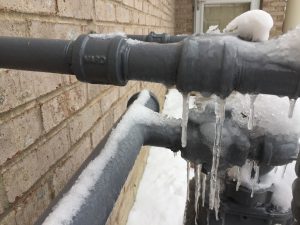Avoiding Frozen Pipes: Effective Methods for Cold Weather
Avoiding Frozen Pipes: Effective Methods for Cold Weather
Blog Article
The content which follows on the subject of Preventing and dealing with frozen pipes is unquestionably captivating. Don't overlook it.

Winter can damage your plumbing, especially by freezing pipelines. Below's how to avoid it from happening and what to do if it does.
Introduction
As temperatures decline, the risk of frozen pipes boosts, potentially leading to expensive fixings and water damage. Recognizing how to stop frozen pipelines is critical for property owners in cold environments.
Recognizing Frozen Pipelines
What triggers pipelines to ice up?
Pipelines ice up when subjected to temperatures listed below 32 ° F (0 ° C) for expanded durations. As water inside the pipes ices up, it broadens, taxing the pipe walls and potentially creating them to rupture.
Threats and problems
Frozen pipelines can lead to water system disturbances, property damages, and costly repairs. Burst pipelines can flooding homes and trigger comprehensive structural damages.
Indicators of Frozen Pipeline
Recognizing icy pipes early can stop them from bursting.
Just how to identify frozen pipes
Search for lowered water circulation from faucets, uncommon smells or sounds from pipes, and noticeable frost on subjected pipelines.
Avoidance Tips
Shielding prone pipelines
Cover pipes in insulation sleeves or use heat tape to shield them from freezing temperature levels. Concentrate on pipes in unheated or exterior areas of the home.
Heating methods
Maintain interior rooms appropriately warmed, especially locations with pipes. Open up cupboard doors to allow cozy air to flow around pipes under sinks.
Securing Exterior Pipes
Yard pipes and exterior taps
Disconnect and drain yard hose pipes before winter season. Mount frost-proof spigots or cover outdoor faucets with protected caps.
What to Do If Your Pipelines Freeze
Immediate actions to take
If you think icy pipelines, keep taps open to soothe pressure as the ice thaws. Use a hairdryer or towels taken in warm water to thaw pipelines gradually.
Long-Term Solutions
Architectural changes
Take into consideration rerouting pipes far from exterior wall surfaces or unheated locations. Include additional insulation to attic rooms, cellars, and crawl spaces.
Updating insulation
Buy high-quality insulation for pipelines, attic rooms, and walls. Proper insulation assists keep consistent temperature levels and decreases the threat of icy pipes.
Verdict
Avoiding icy pipelines requires positive measures and quick responses. By understanding the causes, indicators, and preventive measures, homeowners can protect their pipes during cold weather.
5 Ways to Prevent Frozen Pipes
Drain Outdoor Faucets and Disconnect Hoses
First, close the shut-off valve that controls the flow of water in the pipe to your outdoor faucet. Then, head outside to disconnect and drain your hose and open the outdoor faucet to allow the water to completely drain out of the line. Turn off the faucet when done. Finally, head back to the shut-off valve and drain the remaining water inside the pipe into a bucket or container. Additionally, if you have a home irrigation system, you should consider hiring an expert to clear the system of water each year.
Insulate Pipes
One of the best and most cost-effective methods for preventing frozen water pipes is to wrap your pipes with insulation. This is especially important for areas in your home that aren’t exposed to heat, such as an attic. We suggest using foam sleeves, which can typically be found at your local hardware store.
Keep Heat Running at 65
Your pipes are located inside your walls, and the temperature there is much colder than the rest of the house. To prevent your pipes from freezing, The Insurance Information Institute suggests that you keep your home heated to at least 65 degrees, even when traveling. You may want to invest in smart devices that can keep an eye on the temperature in your home while you’re away.
Leave Water Dripping
Moving water — even a small trickle — can prevent ice from forming inside your pipes. When freezing temps are imminent, start a drip of water from all faucets that serve exposed pipes. Leaving a few faucets running will also help relieve pressure inside the pipes and help prevent a rupture if the water inside freezes.
Open Cupboard Doors
Warm your kitchen and bathroom pipes by opening cupboards and vanities. You should also leave your interior doors ajar to help warm air circulate evenly throughout your home.

I came across that page on How to prepare your home plumbing for winter weather while doing a search on the search engines. Are you aware of somebody who is intrigued by the subject? Be sure promote it. Thank you so much for your time invested reading it.
Schedule Your Service Report this page